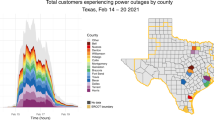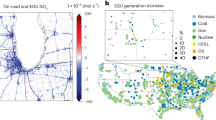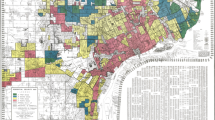Abstract
Environmental justice is the consideration of whether minority and/or lower-income residents in a geographic area are likely to have disproportionately higher exposures to environmental toxins than those living elsewhere. Such situations have been identified for a variety of factors, such as air pollution, hazardous waste, water quality, noise, residential crowding, and housing quality. This study investigates the application of this concept to high-voltage electric power transmission lines (HVTL), which some perceive as a health risk because of the magnetic fields they generate, and also as esthetically unpleasing. We mapped all 345 kV and higher voltage HVTL in New York State and extracted and summarized proximate US Census sociodemographic and housing characteristic data into four categories on the basis of distances from HVTL. Contrary to our expectation, people living within 2000 ft from HVTL were more likely to be exposed to magnetic fields, white, of higher income, more educated and home owners, than those living farther away, particularly in urban areas. Possible explanations for these patterns include the desire for the open space created by the rights-of-way, the preference for new homes/subdivisions that are often located near HVTL, and moving closer to HVTL before EMFs were considered a risk. This study suggests that environmental justice may not apply to all environmental risk factors and that one must be cautious in generalizing. In addition, it shows the utility of geographical information system methodology for summarizing information from extremely large populations, often a challenge in epidemiology.
This is a preview of subscription content, access via your institution
Access options
Subscribe to this journal
Receive 6 print issues and online access
$259.00 per year
only $43.17 per issue
Buy this article
- Purchase on Springer Link
- Instant access to full article PDF
Prices may be subject to local taxes which are calculated during checkout


Similar content being viewed by others
References
Ahlbom A., Day N., Feychting M., Roman E., Skinner J., Dockerty J., Linet M., McBride M., Michaelis J., Olsen J.H., Tynes T., and Verkasalo P.K. A pooled analysis of magnetic fields and childhood leukemia. Br J Cancer 2000: 83 (5): 692–698.
Anderton D.L., Anderson A.B., Oakes J.M., and Fraser M.R. Environmental equity: the demographics of dumping. Demography 1994: 31 (2): 229–248.
Bowen W.M., Salling M.J., Haynes K.E., and Cyran E.J. Toward environmental justice: spatial equity in Ohio and Cleveland. Annals of the Association of American Geographers 1995: 85 (4): 641–663.
Briggs D., Abellan J.J., and Fecht D. Environmental inequity in England: small area associations between socio-economic status and environmental pollution. Soc Sci Med 2008: 67: 1612–1629.
Bryant B., and Mohai P. Race and the Incidence of Environmental Hazards. Westview Press, San Francisco, 1992, 1–251pp.
Centers for Disease C. Health disparities experienced by Hispanics—United States. MMWR 2004: 53 (40): 935–937.
Centers for Disease C. Health disparities experienced by Black or African Americans—United States. MMWR 2005: 54 (1): 1–3.
Cutter S.L., Holm D., and Clark L. The role of geographic scale in monitoring environmental justice. Risk Analysis 1996: 16: 517–526.
Davidson P., and Anderton D.L. Demographics of dumping II: a national environmental equity survey and the distribution of hazardous materials handlers. Demography 2000: 37 (4): 461–466.
Elliott M.R., Wang Y., Lowe R.A., and Kleindorfer P.R. Environmental justice: frequency and severity of US chemical industry accidents and the socioeconomic status of surrounding communities. J Epidemiol Community Health 2004: 58: 24–30.
Elliott P., and Wartenberg D. Spatial epidemiology: current approaches and future challenges. Environ Health Perspect 2004: 112 (9): 998–1006.
Evans G.W., and Kantrowitz E. Socioeconomic status and health: the portential role of environmental risk exposures. Annu Rev Public Health 2002: 23: 303–331.
Greenberg M., and Schneider D. Environmentally Devastated Neighborhoods. Rutgers University Press, New Brunswick NJ, 1996.
Greenberg M., and Cidon M. Broadening the definition of environmental equity: a framework for states and local governments. Population Research and Policy Review 1997: 16: 397–413.
Greenland S., Sheppard A.R., Kaune W.T., Poole C., and Kelsh M.A. A pooled analysis of magnetic fields, wire codes and childhood leukemia. Epidemiology 2000: 11: 624–634.
International Agency for Research on C. IARC Monographs on the Evaluation of Carcionogenic Risks to Humans, 2005.
Maantay J Mapping environmental injustices: pitfalls and potential geographic information systems in assessing environmental health and equity. Environ Health Perspect 2002: 110 (Suppl. 2): 161–171.
National Research Council, and Committee on the Possible Effects of Electromagnetic Fields on Biologic S. Possible Health Effects of Exposure to Residential Electric and Magnetic Fields. National Academy Press, Washington, DC, 1997, 1–356pp..
NIEHS W.o.r.k.i.n.g.G.r.o.u.p.. Assessment of Health Effects from Exposure to Power-Line Frequency Electric and Magnetic Fields, National Institute of Environmental Health Sciences, National Institutes of Health, US Department of Health and Human Services, Public Health Service, Research Triangle Park, NC, 1998: 508.
Pappas G., Queen S., Hadden W., and Fisher G. The increasing disparity in mortality between socioeconomic groups in the United States, 1960 and 1986. N Engl J Med 1993: 329: 103–109. (erratum p. 1139).
Perlin S.A., Setzer R.W., Creason J., and Sexton K. Distribution of industrial air emissions by income and race in the United States: an approach using the Toxic Release Inventory. Environ Sci Technol 1995: 29 (1): 69–80.
Steenland K., Hu S., and Walker J. All-cause and cause specific mortality by socioeconomic status among employed persons in 27 US states, 1984–1997. Am J Public Health 2004: 94 (6): 1037–1042.
United Church of Christ. Toxic Waste and Race in the United States. United Church of Christ, New York, 1987.
USEPA. Volume 1: Workgroup Report to the Administrator. USEPA, Washington, DC, 1992, 1–43.
USGAO. Siting of Hazardous Waste Landfills and their Correlation with Racial and Economic Status of Surrounding Communities. US General Accounting Office, Washington, DC, 1983.
Vine M.F., Degnan D., and Hanchette C. Geographic information systems: their use in environmental epidemiologic research. Environ Health Perspect 1997: 105 (6): 598–605.
Wartenberg D., Greenberg M., and Lathrop R. Identification and characterization of populations living near high voltage transmission lines: a pilot study. Environ Health Perspect 1993: 101 (7): 626–631.
Wartenberg D. Residential EMF exposure and childhood leukemia: meta-analysis and population attributable risk. Bioelectromagnetics 2001: (Suppl. 5): S86–S104.
Wing S., Richardson D.B., Wolf S., Mihlan G., Crawford-Brown D., and Wood J. A case control study of multiple myeloma at four nuclear facilities. Ann Epidemiol 2000: 10: 144–153.
Yandle T., and Burton D. Reexamining environmental justice: a statistical analysis of historical hazardous waste landfill siting patterns in metropolitan Texas. Social Science Quarterly 1996: 77: 477–492.
Zimmerman R. Social equity and environmental risk. Risk Anal 1993: 13 (6): 649–666.
Acknowledgements
The early phase of this study was funded by the Empire State Electric Energy Research Corporation (ESEERCO), and later work by the National Cancer Institute (R03CA77152), NIEHS sponsored UMDNJ Center for Environmental Exposures and Disease (P30ES005022) and the Centers for Disease Control and Prevention (U61/ATU272387 and U19/EH000102). The majority of the writing of the manuscript was completed while Dr. Wartenberg was a Libra Scholar in the Department of Applied Medical Sciences, University of Southern Maine, Portland, Maine. We thank Sylvia Brown, Phil Doyle and Janet Hwang for technical assistance.
Author information
Authors and Affiliations
Corresponding author
Rights and permissions
About this article
Cite this article
Wartenberg, D., Greenberg, M. & Harris, G. Environmental justice: A contrary finding for the case of high-voltage electric power transmission lines. J Expo Sci Environ Epidemiol 20, 237–244 (2010). https://doi.org/10.1038/jes.2009.11
Received:
Accepted:
Published:
Issue Date:
DOI: https://doi.org/10.1038/jes.2009.11
Keywords
This article is cited by
-
The sensitivity of reported effects of EMF on childhood leukemia to uncontrolled confounding by residential mobility: a hybrid simulation study and an empirical analysis using CAPS data
Cancer Causes & Control (2019)
-
Urban Planning and Health Equity
Journal of Urban Health (2011)



